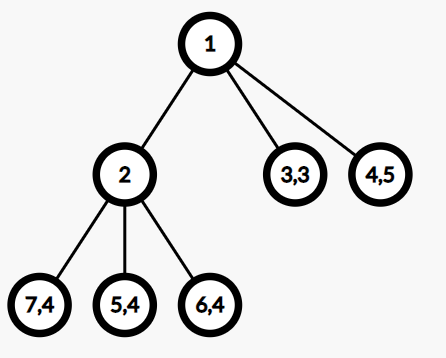Preparando MOJI
A rooted tree is called good if every vertex of the tree either is a leaf (a vertex with no children) or has exactly $$$m$$$ children.
For a good tree, each leaf $$$u$$$ has a positive integer $$$c_{u}$$$ written on it, and we define the value of the leaf as $$$c_{u} + \mathrm{dep}_{u}$$$, where $$$\mathrm{dep}_{u}$$$ represents the number of edges of the path from vertex $$$u$$$ to the root (also known as the depth of $$$u$$$). The value of a good tree is the maximum value of all its leaves.
Now, you are given an array of $$$n$$$ integers $$$a_{1}, a_{2}, \ldots, a_{n}$$$, which are the integers that should be written on the leaves. You need to construct a good tree with $$$n$$$ leaves and write the integers from the array $$$a$$$ to all the leaves. Formally, you should assign each leaf $$$u$$$ an index $$$b_{u}$$$, where $$$b$$$ is a permutation of length $$$n$$$, and represent that the integer written on leaf $$$u$$$ is $$$c_u = a_{b_{u}}$$$. Under these constraints, you need to minimize the value of the good tree.
You have $$$q$$$ queries. Each query gives you $$$x$$$, $$$y$$$ and changes $$$a_{x}$$$ to $$$y$$$, and after that, you should output the minimum value of a good tree based on the current array $$$a$$$.
A permutation of length $$$n$$$ is an array consisting of $$$n$$$ distinct integers from $$$1$$$ to $$$n$$$ in arbitrary order. For example, $$$[2,3,1,5,4]$$$ is a permutation, but $$$[1,2,2]$$$ is not a permutation ($$$2$$$ appears twice in the array), and $$$[1,3,4]$$$ is also not a permutation ($$$n=3$$$ but there is $$$4$$$ in the array).
Each test contains multiple test cases. The first line contains a single integer $$$t$$$ ($$$1 \le t \le 10^4$$$) — the number of test cases. Their description follows.
The first line contains three integers $$$n$$$, $$$m$$$, and $$$q$$$ ($$$1\le n,q \le 2 \cdot 10^5$$$, $$$2\le m \le 2\cdot 10^5$$$, $$$n \equiv 1 \pmod {m - 1}$$$) — the number of the leaves, the constant $$$m$$$, and the number of queries.
The second line contains $$$n$$$ integers $$$a_{1},a_{2}, \ldots, a_{n}$$$ ($$$1 \le a_{i} \le n$$$) — the initial array.
For the following $$$q$$$ lines, each line contains two integers $$$x$$$ and $$$y$$$ ($$$1\le x,y\le n$$$), representing a query changing $$$a_{x}$$$ to $$$y$$$.
It is guaranteed that both the sum of $$$n$$$ and the sum of $$$q$$$ do not exceed $$$2\cdot 10^5$$$.
For each test case, output $$$q$$$ integers in one line, the $$$i$$$-th of which is the minimum tree value after the $$$i$$$-th change.
35 3 33 3 4 4 51 42 43 55 2 43 3 4 4 51 42 53 54 57 3 41 2 2 3 3 3 41 42 15 56 6
6 6 6 7 7 7 8 6 6 6 7
In the first test case, after the first query, the current array $$$a$$$ is $$$[4,3,4,4,5]$$$. We can construct such a good tree:

The first number inside a vertex is its index (in this problem, the indices do not matter, but help to understand the figure). If a vertex is a leaf, the second number inside the vertex is the integer written on it.
We can tell that $$$\mathrm{dep}_{3}=\mathrm{dep}_{4}=1,\mathrm{dep}_{5}=\mathrm{dep}_{6}=\mathrm{dep}_{7}=2$$$ and the value of the tree, which is the maximum value over all leaves, is $$$5+1=6$$$. The value of leaves $$$5$$$, $$$6$$$, $$$7$$$ is also equal to $$$6$$$. It can be shown that this tree has the minimum value over all valid trees.